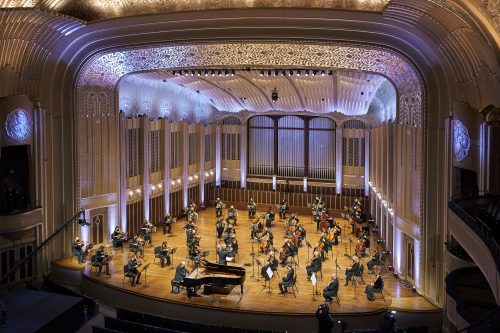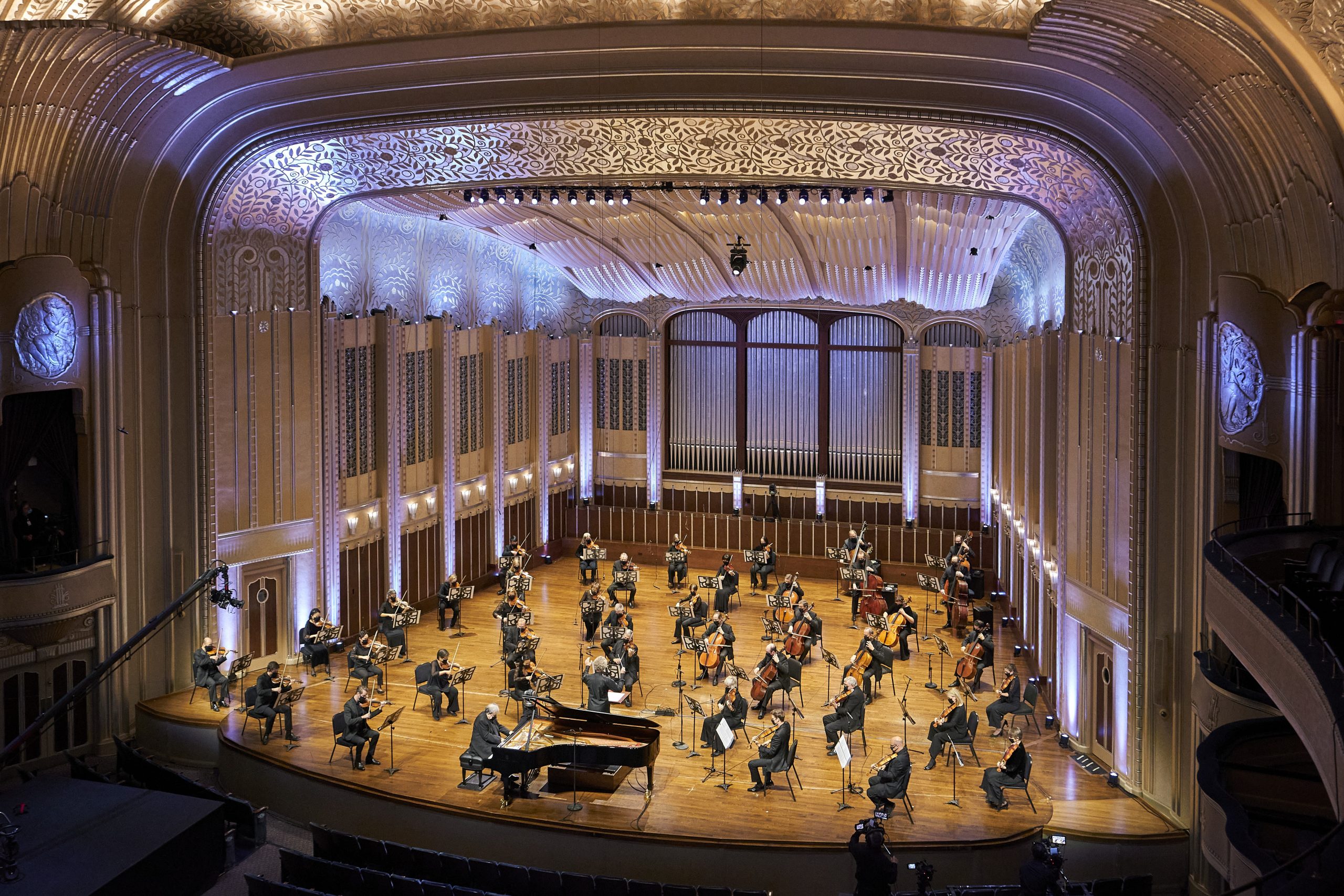 United States In Focus / Episode Two, Bronfman and Beethoven: Yefim Bronfman (piano), strings of the Cleveland Orchestra / Franz Welser-Möst (conductor), Recorded at the Severance Hall, Cleveland, on 15-16.10.2020, and reviewed as a livestream. (MSJ)
United States In Focus / Episode Two, Bronfman and Beethoven: Yefim Bronfman (piano), strings of the Cleveland Orchestra / Franz Welser-Möst (conductor), Recorded at the Severance Hall, Cleveland, on 15-16.10.2020, and reviewed as a livestream. (MSJ)

© Roger Mastroianni
Schnittke – Concerto for Piano and String Orchestra
Beethoven – String Quartet No.10 in E-flat major ‘The Harp’, arranged for string orchestra
There is a time in autumn when the light, temperature and falling leaves give one an uncanny, sinking feeling that can escalate to full panic. While certain pieces of music have passages that resonate with this evocative, creepy time of year, the late Russian composer Alfred Schnittke’s Concerto for Piano and String Orchestra lives there. It opens with a casual gesture of four notes, one pair falling, the other rising back up somewhat. Then with a harmonic shift that casts shadows, the gesture is repeated, with some of the notes stretching slightly deeper. And again. Quietly, but unceasingly, the floor keeps dropping out from beneath you.
Schnittke makes much use of an Alberti bass figure, the gently rocking accompaniment often found in Mozart’s music, but then does the same sinking harmonic side-shift to warp it. Textures darken and clot, and within a minute or so of the opening, the pianist is playing tone clusters low on the keyboard. From tonal to atonal, limpid textures to tangled knots, Schnittke goes everywhere. The loneliness and isolation of the opening pages builds in tension to a frenetic, kinetic outburst, followed by passages where the strings creep into quarter tones, threatening to dissolve reality itself.
At one point, there is even a passage of warped cocktail piano jazz accompanied by plucked double bass, but this too gets warped out of shape as the music twists. After a short but demonic piano cadenza, the music attempts to achieve catharsis with a climax quoting the Adagio of Bruckner’s Seventh Symphony, only here those rich major chords are contaminated with minor thirds, pulling the listener up and down at the same time.
After the attempted catharsis misfires, the concerto settles back into its opening gestures with a nightmarish realization that there is no escape, and the quiet coda is as devastating an expression of quiet horror as I have ever heard. This concerto is a flat-out masterpiece, and we have Yefim Bronfman to thank for its presence here. He took advantage of the enforced hiatus due to the Covid-19 pandemic to learn the piece, and he plays it like a man possessed. From the work’s most thoughtful moments to waves of sound that ring the rafters, Bronfman is ferociously focused and utterly at the height of his powers. Franz Welser-Möst and the Cleveland Orchestra are there with him every step of the way, in a memorable performance that one fervently hopes will make its way to commercial release.
As in the previous concert in this series, the sound is gorgeous, and the video is superb. One felicitous touch was the use of a crane to get some aerial shots of Bronfman at work. At one point, the camera caught the shadow of the conductor’s baton flickering across the piano as Bronfman played, suiting the creepiness of the music perfectly.
The performance of Beethoven’s String Quartet No.10 continues the examination by Welser-Möst and the orchestra of the composer’s late quartets, a fascinating adventure in re-imagining familiar music. It proves above all else how indestructible this music is. While the flying arpeggios of the first movement cannot be as clear with a full symphonic string section as they are in a quartet, here they become gusts of wind on a scene that is less like personal musing and more like a landscape. With that big picture in mind, the depth of sound and bursts of energy generated by the Cleveland strings take this music to new places. The moment in the coda of the first movement where the first violins take off in a burst of high spirits works magnificently here because of the sheer depth of sound the rest of the orchestra makes in support, giving the virtuosic passage more of a grand platform than it has in the original.
Welser-Möst has the strings emphasize the singing line in the slow movement with noble warmth, a positive comfort after the chills of the Schnittke. It is a flowing tempo, yet there’s no feeling of haste in the rolling phrases. As has become characteristic of the Cleveland strings in recent seasons, there is constant sensitivity to the use of vibrato. No longer do they play with a big, all-purpose vibrato. Welser-Möst now has them examine every phrase to decide what level of vibrato is needed, from virtually none to quite a lot. It makes every phrase come alive.
The scherzo is arguably the movement that fares the least well in the transference to a large body of strings because of its speed and intricacy. It does, though, gain something in power, and the Cleveland strings are certainly impressive in their virtuosity. The feathery reserve at the end of the movement is breathtaking. Parts of the finale, too, don’t benefit from large scale treatment, particularly the variations with lots of passagework. But the more introspective and quiet moments have a magnificent feel of power in repose that is aptly Beethovenian. The overall effect is one of vitality. The whirling passages at the end here feel similar to the eruptions of energy at the end of the Leonore Overtures, a sense of health regained, making the overall contrasts of this program particularly rich and satisfying.
Don McClung’s video direction is again supple and flowing, and the sound produced by Elain Martone (famed for her work with the Telarc label for many years) and engineered by Gintas Norvila is full, warm and rich. The only weak link of these In Focus productions remains the program book, designed for smart phone use and missing the orchestra’s traditional program presentation with in-depth notes, full-color pictures and additional commentary, including the performance history of the works. At this point, I would even have to confess to missing the program advertisements, so strange is this pandemic world without the hold-in-hand comfort of the traditional program, something that once seemed as inevitable as autumn in Ohio.
But the music is the thing, and the Cleveland strings under Welser-Möst’s guidance (and with Yefim Bronfman’s intensity in the Schnittke) bring communion and inspiration, and those are sorely needed in this harrowing year.
Mark Sebastian Jordan
For more information on In Focus and this concert click here.
